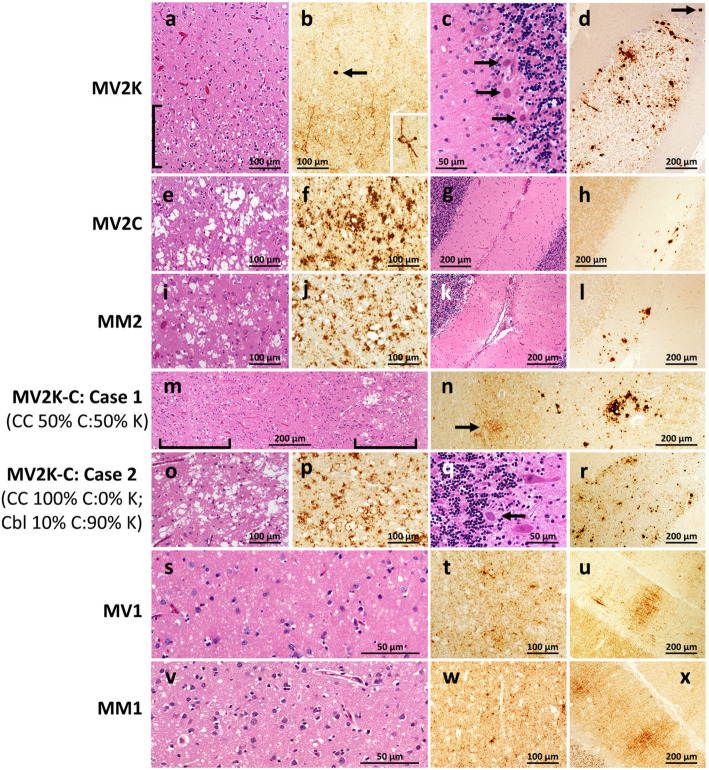Fig. 1.
Histotypes of the sCJDMV2 variants, sCJDMV1 and controls selected for this study. Overall, MV2K subtype (a-d) uniquely features the presence of many kuru plaques in the cerebellum while the cerebral cortex harbors a fine vacuole laminar spongiform degeneration (SD) similar to that associated with VV2; a fine-vacuole, laminar SD ([) in the cerebral cortex (CC); b the cortical region displaying the SD is also more intensely immunostained and shows the characteristic immunostaining of the outer regions of the neuronal bodies and processes (inset) as well as occasional plaque or plaque-like deposits (arrow); c and d three kuru plaques lying at the edge of the granule cell layer of the cerebellar cortex (Cbl) (c) while at lower magnification many plaques are detectable over the granule cell layer, and, occasionally, in the molecular layer (arrow), by immunostaining (d). The MV2C histotype (e-h) closely resembles that of MM2 (i-l) and is characterized by widespread SD made of large-vacuole especially in the cerebral cortex (e and i) and is intensely immunostained (f and j) while the cerebellum is lightly or not affected (g and k) and shows focal immunostaining with large granule and plaque-like formation (h and l). Mixed sCJDMV2K-C cases (m-r) harbor both histotypes in variable ratios that may share the same brain regions or coexist separately; case 1 (m and n) exhibits a ~ 50:50% mixed K and C histotypes in the CC distinguishable by the co-existence of fine- vacuole with laminar distribution (left, lower bracket) and large-vacuole, grape-like SD (right, upper bracket); immunostaining (n) further distinguishes the two characteristic patterns: light perineuronal (arrow) and very intense staining of vacuole clusters that are the characteristics of the K and C components of sCJDMV2K-C; compare m with a and e, and n with b and f, respectively. Case 2 (o-r) harbored exclusively the MV2C histotype in CC (o and p) along with the MV2K histotype in ~ 90% of Cbl (q and r); arrow in q points to a kuru plaque while many plaques can be seen at lower magnification after immunostaining (r). sCJDMV1 (s-u) and -MM1 (v-x) shared the widespread and fine vacuole SD (s and v) and the same pattern of PrPD aggregate formation in CC (t and w) as well as the “brush stroke-like” pattern in Cbl (u and x). Bars indicate magnifications; histological staining H.E.; immunostaining with Ab 3F4 to PrP

